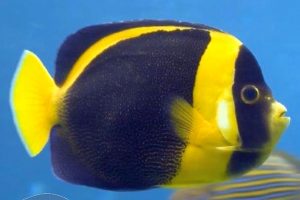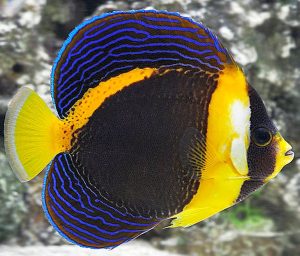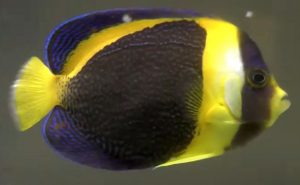Scribbled Angelfish (Chaetodontoplus duboulayi) known to tropical fish keeping enthusiasts as Duboulayi Angelfish, are found in the Indo-West Pacific from Western Australia, Queensland, the Northern Territory, southward to Lord Howe Island, southern New Guinea, and in the Aru Islands of Indonesia.
Scribbled Angelfish are a semi aggressive species that are found at depths between 3 to 65 feet, usually alone, but occasionally in pairs and in small groups. Scribbled Angelfish have been collected on the shallow coastal and inner reefs over rocky or sandy bottoms with little to no coral growth. They are sometimes found around pier pilings but more frequently among seawhips, sponges, corals, and rocks on soft bottoms, rubble, or on open flat bottoms where they graze on algae, sponges and tunicates.
Scribbled Angelfish get their name from the distinctive “scribbled” patterning on their mostly dark blue to black body. Their broad, long dorsal and anal fins are edged in light blue and also have the distinctive “scribbled” pattern with dark and light blue lines. They have dull pale yellow lips with a broad blue black vertical band that runs through the eye to the throat, followed by another broad yellow and white band that separates the body from the head. At the front of the fish, attached to the yellow band just below the dorsal fin, a narrow horizontal yellow stripe begins and gradually widens until it reaches the yellow tail.
Male Scribbled Angelfish are almost indistinguishable from females, but may have a small white patch on the gill cover. They also have a brighter blue body with more prominent and defined horizontal blue scrawling down their sides and there is no interruption of the narrow yellow band that runs from the front of the fish back into the yellow tail. Finally, males have a longer body than fameless.
Female Scribbled Angelfish have an interrupted yellow band that runs from the front into the back of the yellow tail and the dark blue pattern on the sides of the female has more dots, dashes, and random scrawling than males. They also have black dots at the base of the tail fin that interrupt the flow of the continuous yellow line along the back.
Although they are not considered to be “reef safe”, Scribbled Angelfish can be housed in a selective reef tank with few if any hard corals. They coexist with mushroom corals, sea anemones, and soft corals from the Sinularia, Lobophytum, Lemnalia, and Cladiella genra. Except for tridacnid clams, scallops, oysters, tubeworms, and possibly a leg or two from severed from a starfish; most invertebrates are usually ignored, and crabs, shrimp, and snails are generally left alone.
Scribbled Angelfish need plenty of swimming space and copious amounts of mature live rock to thrive in an aquarium environment. Juvenile Chaetodontoplus duboulayi can be housed in a 55 or 60 gallon aquarium to start, but a single adult needs a tank of at least 100 gallon capacity or more.
A male and female Scribbled Angelfish can be housed in a larger tank of at least 125 gallon capacity provided they are introduced at the same time. A much larger tank of 250 to 300 gallons or more is needed if you plan to keep them with others of the same genus.
Chaetodontoplus duboulayi do well in a community aquarium with other peaceful to semi aggressive species. They do not do well with Holacanthus and Pomacanthus angelfish which are too aggressive, dottybacks and other similarly aggressive species, and angelfish with similar coloring.
In general, Scribbled Angelfish need a large mature aquarium with plenty of aged live rock with algae growth for them to graze on and arranged so they have plenty of free swimming space. The live rock should be arranged into caves, overhangs, and crevices for them to hide among when they feel threatened, especially for juveniles. They prefer strong tidal currents, so at least a couple of powerheads in their tank would be appreciated. Lighting should be moderately strong to strong in at least one area of the tank to promote the growth of algae.
Scribbled Angelfish are very sensitive to poor water quality. Keeping the nitrates under 20 ppm and the pH between 7.8 and 8.4 is necessary to keep the fish healthy. Normal reef maintenance with regular water changes should be considered the norm.
Although captive breeding has not yet been successfully accomplished in an aquarium environment, they have been observed mating. The male’s rapidly swimming courtship behavior begins about an hour before sunset or before the lights are turned off and continues for about an hour afterwards. The male swims rapidly around the female with his body inclined to one side but does not engage in the soaring behavior that wild pairs exhibit. The female ignores the male until she is ready to spawn. The female swims to the mating site and as the pair rises in the water column , the male nuzzles the abdomen of the female until spawning occurs. The male then chases the female back to the reef or rocks. Fertilized eggs hatch in about 24 hours and the small .94 to 1.02 inch larvae receive no parental care. Additional spawning sometimes occur during the same evening.
In their natural environment, Scribbled Angelfish feed primarily on algae, sponges, and tunicates. In an aquarium environment they should be fed a varied diet of fresh, frozen, and freeze dried Spirulina, marine algae, Mysis or frozen shrimp, chopped clam, squid, octopus, and other meaty items. Feeding small portions twice a day is recommended.
Scribbled Angelfish (Chaetodontoplus duboulayi) are occasionally available to tropical fish keeping enthusiasts in stores and online at a variety of sites and are usually quite expensive. When purchasing a Scribbled Angelfish its best to acquire a large juvenile or small adult. Mature adults have a much harder time acclimating to captivity.
Approximate purchase sizes: Female: Small: 1-1/2″ to 2″; Small/Medium: 2″ to 3″ Medium: 3″ to 4″; Medium/Large: 4″ to 5″; Large: 5″ to 6″; XLarge: 6″ to 7″; Male: Large 5″ to 6″ XLarge 6″ to 7″ XXLarge 7″ to 9″ Show Size 9″ to 11″.
Minimum Tank Size: 60 gallons for juveniles, 180 gallons for adults
Aquarium Type: Fish only tank
Care Level: Moderate
Temperament: Semi Aggressive
Aquarium Hardiness: Very hardy
Water Conditions: 72-80°F, dKH 8 to 12, pH 8.1-8.4, sg 1.023-1.025
Max. Size: 11″
Color Form: Black, Yellow, Blue
Diet: Omnivore
Compatibility: Compatible with caution
Origin: Australia
Family: Pomacanthidae
Lifespan: Up to 20 years
Aquarist Experience Level: Intermediate




